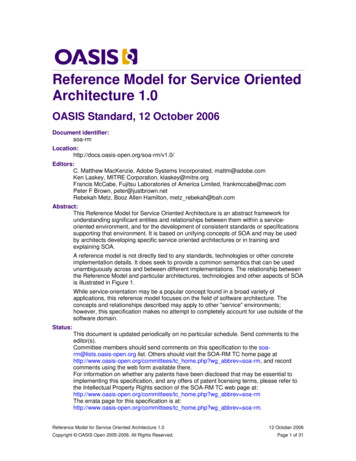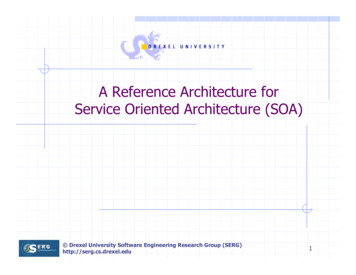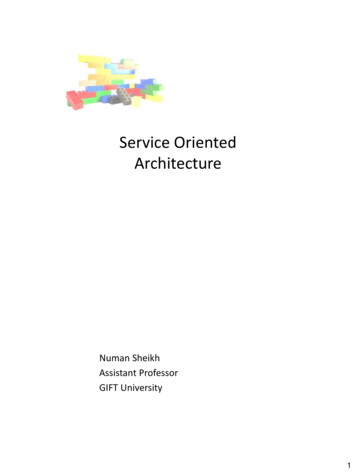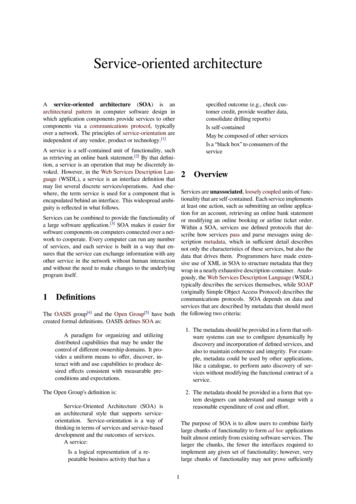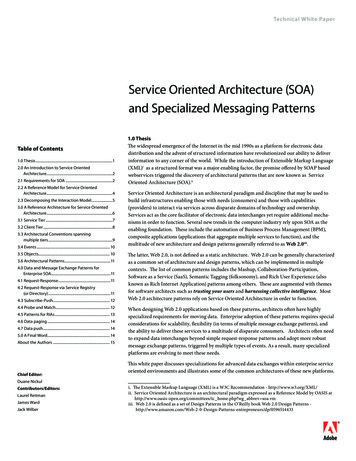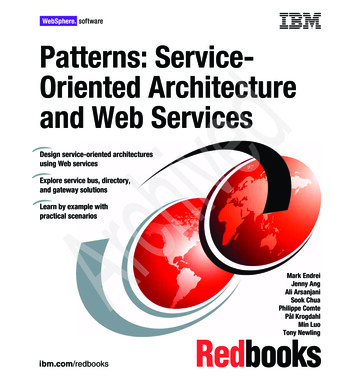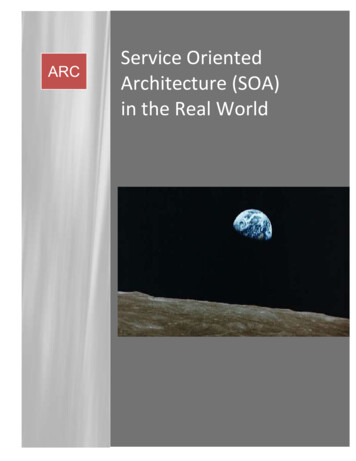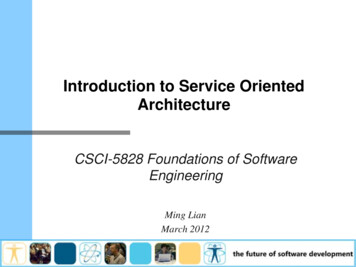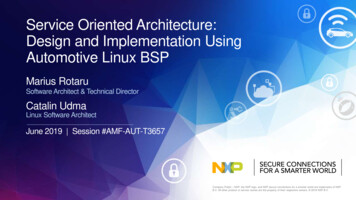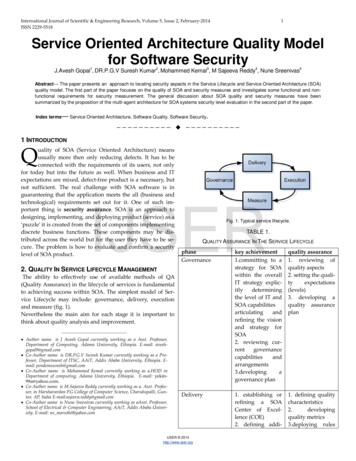
Transcription
International Journal of Scientific & Engineering Research, Volume 5, Issue 2, February-2014ISSN 2229-55181Service Oriented Architecture Quality Modelfor Software SecurityJ.Avesh Gopal1, DR.P.G.V Suresh Kumar2, Mohammed Kemal3, M Sajeeva Reddy4, Nune Sreenivas5Abstract— The paper presents an approach to locating security aspects in the Service Lifecycle and Service Oriented Architecture (SOA)quality model. The first part of the paper focuses on the quality of SOA and security measures and investigates some functional and nonfunctional requirements for security measurement. The general discussion about SOA quality and security measures have beensummarized by the proposition of the multi-agent architecture for SOA systems security level evaluation in the second part of the paper.Index terms— Service Oriented Architecture, Software Quality, Software Security.—————————— ——————————1 INTRODUCTIONQuality of SOA (Service Oriented Architecture) meansusually more then only reducing defects. It has to beconnected with the requirements of its users, not onlyfor today but into the future as well. When business and ITexpectations are mixed, defect-free product is a necessary, butnot sufficient. The real challenge with SOA software is inguaranteeing that the application meets the all (business andtechnological) requirements set out for it. One of such important thing is security assurance. SOA is an approach todesigning, implementing, and deploying product (service) as a‘puzzle’ it is created from the set of components implementingdiscrete business functions. These components may be distributed across the world but for the user they have to be secure. The problem is how to evaluate and confirm a securitylevel of SOA product.IJSERFig. 1. Typical service lifecycle.TABLE 1.QUALITY ASSURANCE IN THE SERVICE LIFECYCLEphaseGovernancekey achievement1.committing to astrategy for SOAwithin the overallIT strategy explicitlydeterminingthe level of IT andSOA capabilitiesarticulatingandrefining the visionand strategy forSOA2. reviewing lopingagovernance planquality assurance1. reviewing ofquality aspects2. setting the qualityexpectations(levels)3. developing aquality assuranceplanDelivery1. establishing orrefining a SOACenter of Excellence (COE)2. defining addi-1. defining qualitycharacteristics2.developingquality metrics3.deploying rules2. QUALITY IN SERVICE LIFECYCLE MANAGEMENTThe ability to effectively use of available methods of QA(Quality Assurance) in the lifecycle of services is fundamentalto achieving success within SOA. The simplest model of Service Lifecycle may include: governance, delivery, executionand measure (fig. 1).Nevertheless the main aim for each stage it is important tothink about quality analysis and �——— Author name is J Avesh Gopal currently working as a Asst. Professor,Department of Computing, Adama University, Ethiopia. E-mail: aveshgopal9@gmail.com Co-Author name is DR.P.G.V Suresh Kumar currently working as a Professor, Department of ITSC, AAiT, Addis Ababa University, Ethiopia. Email: pendemsuresh@gmail.com Co-Author name is Mohammed Kemal currently working as a.HOD inDepartment of computing, Adama University, Ethiopia. E-mail: yekin99a@yahoo.com. Co-Author name is M.Sajeeva Reddy currently working as a. Asst. Professor, in Harshavardan P.G College of Computer Science, Charukupalli, Guntur, AP, India E-mail:sajeeva.reddy@gmail.com Co-Author name is Nune Sreenivas currently working as aAsst. Professor,School of Electrical & Computer Engineering, AAiT, Addis Ababa University. E-mail: ns maruthi@yahoo.comIJSER 2014http://www.ijser.org
International Journal of Scientific & Engineering Research, Volume 5, Issue 2, February-2014ISSN 2229-5518Executiontional capabilitiesrequired, such asupgrades to the ITinfrastructure3. agreeing on policies for servicereuse across linesof business4. putting fundingmechanismsinplace to encouragethis reuse5.establishingmechanismstoguarantee servicelevels .1. deploying newandenhancedgovernancearrangements2. deploying technology to discoverand manage assets3. communicatingand educating expected behaviorsand practices within both the business and IT decision-makingcommunities4. enabling thepolicy infrastructure5. executing theservice1.monitoringcompliance withpolicies and governance arrangements, such asservicelevelagreements(SLAs), reuse levels, and changepolicies2.analyzingITeffectiveness metricsof result’s interpretation4. founding procedures for testing5. establishing system of work’sdocumentation2SOA quality model should address multiple aspects of servicequality across SOA service implementations. In fact, two aspects seem to be the most important – software product andbusiness process quality (fig. 2). Both of them determiningfinal quality of the service, which depends on final user expectations and feelings. Companies to ensure top SOA quality ofservice have to meet customer’s business requirements, improve their satisfaction and profitability as well as ensure thehighest level of software reliability.1. deploying quality assurance model2. using externaltools and application to servicequality analysis .IJSERMeasureFig. 2 SOA quality model1. monitoring andanalyzing valuesof quality metrics3.1 Quality of business processOne of the model for business process quality analysis wasdefined by A.Selcuk Guceglioglu and Onur Demirirs (fig. 3). Itpresents a complementary process-based approach and focusing on the quality aspect of the process [15]. The structure ofthe model is based on ISO/IEC 9126, so includes: categories (aspects) of quality; characteristics (functionality, reliability, usabilityand maintainability); subcharacteristics; metrics (to analyze quality attributes)2.communicatingwithin team toimproveservicequality.3 SOA QUALITY MODEL AND SECURITY METRICSFig. 3 Model for business process qualityIn this model security (of the business process) is a part of itsfunctionality and may be measured using access auditabilitymetrics.IJSER 2014http://www.ijser.org
International Journal of Scientific & Engineering Research, Volume 5, Issue 2, February-2014ISSN 2229-55183.2 Quality of software productOne of the well-known model of standard for description thesoftware product quality is ISO/IEC9126 Software engineering— Product quality. It defines six quality characteristics (subdivided into subcharacteristics) for internal and external qualityand four characteristics for quality-in-use (fig. 4).Fig. 4 ISO 9126 model for software product qualityISO/IEC 9126 may be used to specify and evaluate softwareproduct quality from different perspectives. It is dedicated forusers linked with analysis of requirements, development,evaluation, maintenance, use or audit software and typicalexamples of its use are to: validate the completeness of a requirements definition; identify software requirements; identify software design objectives; identify software testing objectives; identify quality assurance criteria; identify acceptance criteria for a completed software product.Security according to ISO/IEC 9126 means ―the capability ofthe software product to protect information and data so thatunauthorised persons or systems cannot read or modify themand authorised persons or systems are not denied access tothem‖ [14]. It has several metrics, e.g. access auditability, accesscontrolability, data corruption prevention, data encryption.3within this model. Definition of security proposed in this document is ―the capability of the software product to protectinformation and data so that unauthorized persons or systemscannot read or modify them and authorized persons or systems are not denied access to them‖. These two documentsdevoted to software quality measurement are the main set ofguidelines to elaborate the security level evaluation framework for SOA systems.4.1 Security Requirements and Security Measures forSoftware DevelopmentThere are several well known problems and controversieswhile defining the exact meaning of the security metrics[1,6,12]. There is no one metrics that is acceptable and applicable in context of all possible systems and situations. The security metrics are highly context dependant, so the final shape ofthe metrics is related to a situation and target depend on security goals, technical, organizational, and operational needs,available resources, etc. At the other hand, metrics are essential in measuring the goodness of target system and it is alsotrue in the context of security quality evaluation, so there iscontinuous need for security metrics definition.As a system activity cannot be managed well if it cannot bemeasured, metrics provide the manager with instrumentswhich enable to characterize, to evaluate, to predict and toimprove process execution. Security metrics and measurements can be used for decision support, especially in assessment and prediction. Exemplary security metrics for securityassessment include [10]: Risk management activities in order to mitigate security risks, Comparison of different security controls or solutions, Obtaining information about the security posture ofan organization, a process or a product, Security assurance of a product, an organization, ora process, Security testing (functional, red team and penetration testing) of a system, Certification and evaluation (e.g. based on Common Criteria) of a product or an organization, and Intrusion detection in a system, Other reactive security solutions such as antivirussoftware.For example, to predict the security behavior of an organization, a process or a product in the future some metrics usingmathematical models and algorithms can be applied to collectand analyze measured data (e.g. regression analysis).IJSER4 SECURITY LEVELITY MEASUREMENTEVALUATION FOR SOFTWARE QUAL-The IEEE standard for a Software Quality Metrics Methodology describes software quality as the degree to which softwarepossesses a desired combination of quality attributes [2g]. Inthis context the crucial element for the quality measurementare quality attributes which are also called quality characteristics. Quality attributes can be classified into two main categories: execution qualities - such as security and usability, whichare observable at run time, and evolution qualities - such astestability, maintainability, extensibility and scalability, whichare embodied in the static structure of the software system [8].According to ISO software quality model [3], security is acomponent of functionality category which is one of the sixcategories of quality characteristics that has been definedA security metric can be qualified as objective or subjective,quantitative or qualitative, dynamic or static, relative or absolute, and direct or indirect [13]. The ISO/IEC 9126 propose ex-IJSER 2014http://www.ijser.org
International Journal of Scientific & Engineering Research, Volume 5, Issue 2, February-2014ISSN 2229-5518ternal, internal and indirect metrics categories. The internalmetrics are understood as static measure products. This metrics measure quality only indirectly. It has also been assumedthat at the early stages of development only resources andprocess can be measured [11]. The external metrics of thisstandard measure code when during execution. The indirectmetrics is a metric of quality in use. According to SOA systemscharacteristics there are some specific requirements thatshould be taken into account while considering securitymeasurement.4.2 Security Assessment in SOAThe security evaluation process should be based on some formal prerequisites. This means that the security evaluation mustbe objective to guarantee the repeatability and universality ofthe evaluation results. So, there must be defined notion of thesecurity measure. There are some confusion about this notion.The first problem is that the security measure does not have anyspecific unit. The other difficulties are: security level has no objective grounding but it only in some way reflects the degree inwhich our expectation about security agree with reality, securitylevel evaluation is not fully empirical process, etc.ServicetionDescrip-ervice Communication ProtocolTransport4servicesAuthentication of theservicesManagement of securityof the complex servicesDescription completenessAvailabilityProtection from attacksConfidentialityAuthenticationNorms complianceAvailabilityProtection from attacksIntegrityService DescriptionServiceCommunication ProtocolTransportThe most important functionality related to the SOA securitylevel evaluation architecture is description of the all components, mechanisms and relations that are necessary to precisely evaluate the security level of the particular SOA system. Asit was described in this section the problem of security evaluation is very complex and there exist more than one solutionthat could be acceptable within a context of a particular system and its environment. We propose some general idea aboutSOA security level evaluation in a relation to requirementslisted in the table 1g. The central part of the proposition is amulti-agent architecture presented in the fig. 2g. The multiagent architecture is composed of three types of agents: monitoring agents that tests the various security parameters relatedto particular SOA layer, superior agents that manage the activity of monitoring agents, managing agents that are responsiblefor all superior agents and for communication with serviceconsumer agents. This type of architecture was selected according to its correspondence to SOA characteristic. Within thearchitecture monitoring agents are responsible for performingthe task related to security assessment using the selected metrics while the managing agent should provide the final results.The next step of the research will be devoted to the problem ofselection or elaboration of appropriate for SOA systems security measures for monitoring agents and data fusion methodsfor managing agent.IJSERFig. 5 The layered model of Service Oriented ArchitectureAs the SOA system can be defined by its five functional layers(fig.5) the correspondent definition of SOA security requirementsfor security evaluation process should address the specific security problems within each layer. Some elements from a set definingsecurity requirements for the SOA layers has been presented inTable 1. describing functional and non-functional security evaluation requirements for each of the SOA functional layers (selection). The complete list can be found inTABLE 2FUNCTIONAL AND NON-FUNCTIONAL REQUIREMENTSFOR SECURITY MEASUREMENTSOA LayerPolicy and Business ProcessesServiceEvaluate/verify/testPolicy consistencyPolicy completenessTrust managementIdentity managementIdentification of theSOA LayerPolicyandBusiness ProcessesServiceFig. 6 The architecture of the multi-agent system for SOA security levelevaluationIJSER 2014http://www.ijser.org
International Journal of Scientific & Engineering Research, Volume 5, Issue 2, February-2014ISSN 2229-5518Where: AMOL – SOA functional layer monitoring agents ASL – SOA functional layer superior agents AM – SOA managing agents AC – the agents of consumers of SOA system services5 CONCLUSIONSImproved interoperability is one of the most prominent benefits of SOA. This type of the systems allows service users totransparently call services implemented in disparate platformsusing different languages. However, one of the challenges ofeliciting quality requirements for a system is that it may not bepossible to know all the collaborating parts. This is especiallytrue in SOA-based systems that provide public services and/orsearch for services at runtime.A quality measures allows to judge quality of the systems.Quality requirements, such as those for performance, security,modifiability, reliability, and usability, have a significant influence on the software architecture of a system. The use of a service-oriented approach positively impacts some quality attributes, while introducing challenges for others. This paper presented the impact of SOA characteristic on different qualitymeasures. The first part of the paper discussed quality of SOAand security measures and some functional and nonfunctional requirements for security measurement and thenthe proposition of the novel multi-agent architecture for SOAsystems security level evaluation has been presented in thesecond part. The future work will concentrate on the evaluation of the proposed architecture for security assessment andrefinement of the security measures.REFERENCES5- 31, 2007). ICSEA. IEEE Computer Society, Washington (2007)[8] Savolainen, P., Niemela, E., and Savola, R., A Taxonomy of Information Security for Service-Centric Systems. In Proc. of the 33rd EUROMICRO Conference on Software Engineering and Advanced Applications EUROMICRO. IEEE Computer Society, Washington, DC, 512 (2007)[9] Vaughn, R.B.J., Henning, R., and Siraj, A. Information assurancemeasures and metrics - state of practice and proposed taxonomy. inProceedings of 36th Hawaii International Conference on System Sciences (HICSS03). 2003.IJSER[1] ISO/IEC 9126-1, Software engineering — Product quality — Part 1:Quality model. 2001[2] ISO/IEC 9126-2, Software engineering — Product quality — Part 2:External metrics. 2003.[5] ISO/IEC 9126-3, Software engineering — Product quality — Part 3:Internal metrics. 2003[3] Kaner C., Bond W.P., 10th International ―Software Engineering Metrics: What Do They Measure and How Do We Know?‖, Software Metrics Symposium, METRICS 2004[4] Kolaczek G., Multi-agent Security Evaluation Framework for ServiceOriented Architecture Systems, to appear in Lecture Notes in Computer Science, Lecture Notes in Artificial Intelligence, (2009)[5] Matinlassi, M. and Niemelä, E. The impact of maintainability on component-based software systems. in Proceedings of 29th EuromicroConference: New Waves in System Architecture. 2003. Belek-Antalya,Turkey: IEEE Computer Society.[6] NIST 800-55, Swanson M., Nadya B., Sabato J., Hash J., Graffo L.,―Security Metrics Guide for Information Technology Systems‖, National Institute of Standards and Technology Special Publication #80026, (2003).[7] Savola, R. Towards a Security Metrics Taxonomy for the Informationand Communication Technology Industry. In Proceedings of the international Conference on Software Engineering Advances (August 25IJSER 2014http://www.ijser.org
Service Oriented Architecture Quality Model for Software Security J.Avesh Gopal. 1,DR.P.G.V Suresh Kumar. 2, Mohammed Kemal. 3, M Sajeeva Reddy. 4, Nune Sreenivas. 5. Abstract — The paper presents an approach to locating security aspects in the Service Lifecycle and Service

